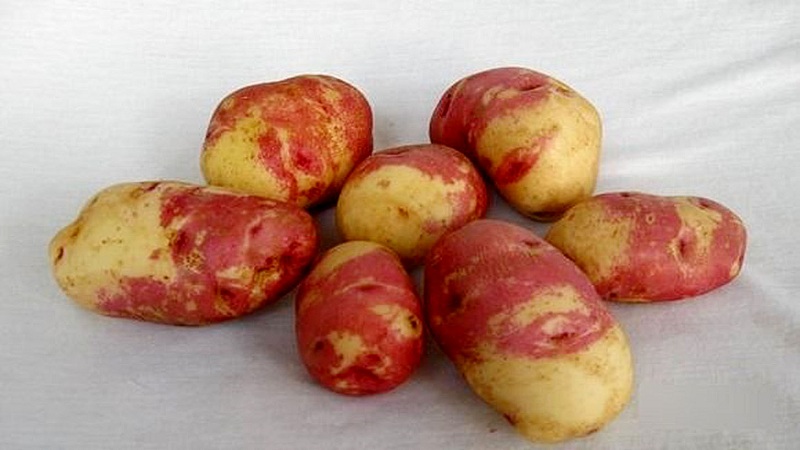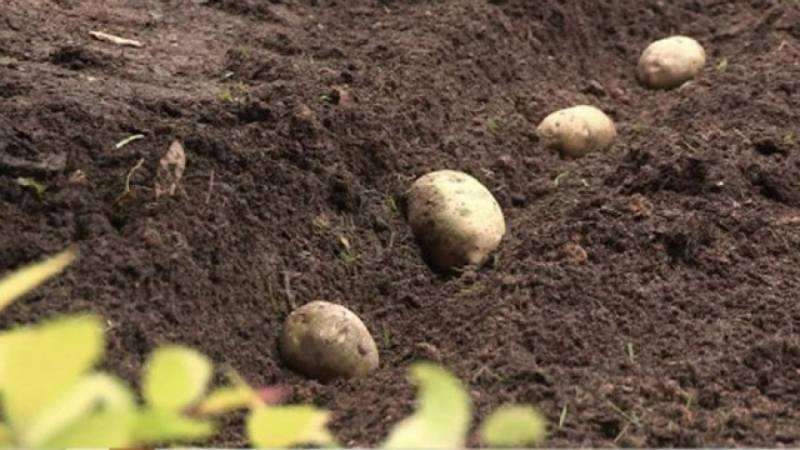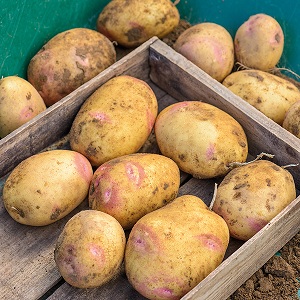Potato variety Limonka: description, characteristics and reviews
Lemon is the second name of the Picasso potato variety, known in many regions of our country. A late-ripening Dutch variety named after the "pink" period of Pablo Picasso's work. The master painted his paintings in pink, with the addition of yellow and gray. The tubers are also colored yellow and pink.
In this article you will find a detailed description of Limonka potatoes with reviews and photos, learn about its advantages and disadvantages of the variety, growing methods, ways to combat late blight, wireworm and Colorado potato beetle.
The content of the article
Description of the variety
Potato Limonka is a common name for a variety known to many gardeners Picasso... The cultivation was carried out by the Dutch breeders of the Agrico company. The variety was included in the list of breeding achievements in the Russian Federation in 1995.
Patents for the sale of seed material have:
- FSBSI "All-Russian Research Institute of Potato Farming" A.G. Lorkha ";
- ZAO Oktyabrskoe;
- LLC Alchak;
- LLC ETK "Meristemnye kultury";
- CJSC "Breeding farm" Prinevskoye ";
- LLC Agrofirma Slava Potato;
- SPK "Agrofirma" Elite Potato ".
In the photo - potatoes Limonka (Picasso).

The table contains the main characteristics of the variety.
| Indicators | Characteristic |
| Ripening period | 110-120 days |
| Bush | Tall, spreading |
| The number of tubers in the bush | 15-19 |
| Weight | 75-125 g |
| The form | Round oval |
| Coloration | Skin - yellow, with small pink eyes, cream-colored flesh |
| Leaves | Large, dark green |
| Corolla color | White |
| Starch content | 8-13% |
| Taste | Excellent (5 on a five-point scale) |
| Cooking class / group | A / B (weakly boiled) |
| Yield | In the Central region - 193-315 c / ha, in the Central Black Earth - 190 c / ha |
| Marketability | 80-94% |
| Keeping quality | 83-90% |
| Appointment | Dining room |
| Sustainability | To potato crayfish, golden nematode, leaf-roll virus, common scab |
| Transportability | High |
Chemical composition
The table shows the vitamin and mineral composition of raw, unpeeled potatoes (per 100 g of product).
| Name | Content | Norm |
| Beta carotene | 0.001 mg | 5 mg |
| Vitamin B1 | 0.081 mg | 1.5 mg |
| Vitamin B2 | 0.032 mg | 1.8 mg |
| Vitamin B4 | 12.1 mg | 500 mg |
| Vitamin B5 | 0.295 mg | 5 mg |
| Vitamin B6 | 0.298 mg | 2 mg |
| Vitamin B9 | 15 mcg | 400 mcg |
| Vitamin C | 19.7 mg | 90 mg |
| Vitamin E | 0.01 mg | 15 mg |
| Vitamin K | 2 μg | 120 mcg |
| Vitamin PP | 1,061 mg | 20 mg |
| Potassium | 425 mg | 2500 mg |
| Calcium | 12 mg | 1000 mg |
| Magnesium | 23 mg | 400 mg |
| Sodium | 6 mg | 1300 mg |
| Phosphorus | 57 mg | 800 mg |
| Iron | 0.81 mg | 18 mg |
| Manganese | 0.153 mg | 2 mg |
| Copper | 110 mcg | 1000 mcg |
| Selenium | 0.4 μg | 55 mcg |
| Zinc | 0.3 mg | 12 mg |
Growing regions and planting dates
Potatoes Limonka gained access to cultivation in the following regions of the Russian Federation:
- Central (Bryansk, Vladimir, Ivanovo, Kaluga, Moscow, Ryazan, Smolensk, Tula regions);
- Central Black Earth (Belgorod, Voronezh, Kursk, Lipetsk, Oryol and Tambov regions).
Landing produced in late April - early May, taking into account weather conditions.
Advantages and disadvantages

Advantages:
- great taste;
- suitable for dietary nutrition due to its low starch content;
- attractive appearance;
- keeping quality;
- the possibility of transportation over long distances;
- immunity to dangerous viral and fungal diseases;
- unpretentious care;
- drought tolerance.
The disadvantage is a predisposition to late blight of tubers and tops.
Reference. According to one version, the potato came to Europe thanks to the monk Neronim Kordan at the end of the 16th century. But until the end of the 18th century, people did not eat it even during the period of famine, considering the fruits to be poisonous, causing fatal diseases. The berries of potatoes are really poisonous, and people guessed to eat the tubers a little later.
Features of planting and growing
Potato Limonka is distinguished by undemanding care procedures, resistance to heat and moisture deficit, soil type. To increase productivity and maintain taste, plants are fed with organic matter and mineral complexes.
Agricultural technology of the variety is standard. Planting is watered as needed, loosening of the earth crust, weeding, hilling, preventive spraying from fungi and insect pests is carried out.
Preparing for landing
Lemon is a late-ripening variety, so preparatory work begins in early April, 2-3 weeks before planting. The soil should warm up to a temperature of + 7 ... + 10 ° С, air up to + 14 ° С.
Tuber germination accelerates maturation. The seeds are taken out of a cool room into a warm, bright place with an air temperature of + 15 ° C. The tubers are sorted, treated with a disinfecting pink solution of potassium permanganate or "Fitosporna", laid out in an even layer on the floor and wait for the sprouts to appear.
The day before planting, the seeds are immersed in growth stimulants "Epin" or "Zircon".
In the fall, the selected area is dug up and fertilized with manure, in the spring it is sown with wheat, lupine, rye, flax, and mustard. After 30 days, the siderates are mowed and embedded in the ground. Overripe hay saturates the earth with nitrogen, loosens, provides free air access at the roots, and prevents the growth of pathogenic microorganisms.
Landing scheme and technology
The standard potato planting technology provides for the formation of holes for a shovel, to a depth of 15-20 cm. Large potatoes are divided into parts so that at least three eyes remain on each. Each time the knife is dipped in a strong solution of potassium permanganate, and the cut is sprinkled with wood ash. Pour 1 tbsp into the pits. l. ash and superphosphate.
At least 50 cm is left between the holes, taking into account the spreading of the bushes. When planting thickens, tubers bulge out of the ground and turn green in the sun. The row spacing is 60–70 cm.

Care
Rules for caring for potatoes Limonka:
- The variety does not require systematic watering and is content with rainwater. But in the dry period, the plants are watered every 10 days from a watering can under the root or hoses are installed for drip moisture supply.
- They must be weeded and loosened to saturate the roots with moisture and oxygen.
- When hilling, weeds are simultaneously uprooted and the roots are enriched with oxygen. The first time the bushes are spudded 2-3 weeks after planting the tubers, the second - after flowering.
- Harrowing is suitable for caring for plantings occupying more than 2-3 acres. A harrow is hung on a walk-behind tractor or tractor. The tines tear the weeds out of the soil and loosen it deeply.
- Lemon is fed with organics and minerals. During the season, plants are fertilized three times: after the emergence of shoots, before budding and during the flowering period.
The table shows the feeding scheme.
| Application period | Top dressing | |
| 1st portion | 14 days after germination | 20 g of dry chicken manure, 25 g of urea per 10 l of water at room temperature, at the root of 500 ml |
| II portion | Before budding | 15 g of superphosphate and potassium sulfate per 10 l of water, at the root of 500 ml |
| III portion | During flowering | 2 g of sodium humate per 10 l - for spraying bushes |
Features of cultivation and possible difficulties
Potatoes Limonka adapted for cultivation in the Central and Central Black Earth region. Here, the variety shows maximum productivity. In other regions of Russia, with appropriate agricultural technology, different harvest volumes are harvested, depending on the climate.
Difficulties are possible in the southern regions.Under the scorching sun, potatoes rapidly degenerate and stop their development at the beginning of summer. Farmers have to experiment to preserve their crops. For example, tubers are planted in early July, bypassing the peak of the heat. The warm period in the southern region lasts until mid-autumn, so the harvest is harvested at the end of October.
For planting Lemons use an alternative method - in the grass. This significantly reduces planting and maintenance labor costs. The main task of the gardener is the preliminary harvesting of grass, straw or hay in large quantities.
Rope and wooden pegs are used to mark the beds. The width between the rows is 50-60 cm. 2-3 tubers are placed in the beds at a distance of 20-30 cm in a checkerboard pattern and mulched with a layer of straw 20 cm. During the growing season, cut grass and weeds are poured onto the beds, renewing the mulch. Additional watering and fertilization is not required. An optimal moist environment is formed inside the beds, and the potatoes receive all the nutrients from rotted hay.
Disease and pest control
The variety is prone to late blight infection. The disease has characteristic features: dark spots on potatoes and greenery, white, pubescent bloom on the back of the leaves.
To prevent planting, Lemons are sprayed with Bordeaux liquid, pollinated with wood ash 15 days after planting.
Late blight treatment:
- before budding - "HOM", "Oksikhom", twice in 10 days;
- after flowering - "Bravo", three times in 10 days;
- before harvesting - once "Alufit".
Prevention:
- crop rotation;
- sparse fit;
- disinfection of seeds;
- picking potatoes in dry, sunny weather;
- application of potassium-phosphorus fertilizers;
- control of nitrogen in the soil.
Potato plantings infect the larvae of the click beetle (wireworm). They gnaw holes in tubers and, if widely spread, affect most of the crop. To destroy the pest, starlings, blackbirds, rooks, tits are attracted to the site, the area is sprinkled with crushed eggshells, ammonium nitrate (30 g / sq. M), and the plantings are sprayed with the preparations "Decis", "Barguzin".
Potato tops are destroyed by the Colorado potato beetle. To scare away insects, mustard or lupine are sown near the potatoes. For irrigation, chemicals are used: "Tabu", "Aktara", "Prestige", "Killer", "Colorado potato beetle NO!", "Corado".
Traditional methods:
- dusting with gypsum, birch ash, corn flour.
- decoction of poplar foliage (1 kg of greenery per 10 liters of water, boil, cool and bring the volume to 10 liters);
- infusion of sunflower flowers (0.5 kg of fresh raw materials per 10 liters of water);
- infusion of celandine (1.5 kg of herbs per 10 liters of boiling water).
Harvesting and storage

Potatoes are dug in dry, sunny weather. Any spraying of the plants is stopped 20 days before harvesting.
Late-ripening tubers are perfectly stored in the cellar until spring, do not deteriorate, and do not germinate. The potatoes are sorted, healthy specimens are selected and left to dry for 3-4 days outside under a canopy. Then they are distributed in plastic, wooden boxes, burlap, nets.
Potatoes can be stored with beets, which absorb moisture to prevent rotting.
In a city apartment, potatoes are stored on a glazed balcony. Suitable boxes, insulated with foam, special thermal containers that are mounted on the wall or placed on a hill so that the bottom does not touch the cold floor.
Such balcony cellars are available in three versions:
- for 1 bag - 100 l;
- for 2 bags - 180 l;
- for 3 bags - 300 l.
Advice... Inspect and sort the tubers periodically by removing the tubs completely. Throw away the rotten ones.
Potatoes Lemon is used for cooking, frying, baking, stewing, making soups, salads, potato pancakes, mashed potatoes. The tubers are not boiled during heat treatment.
Farmer advice and feedback
Reviews of gardeners about the variety are positive. The culture is valued for its attractive presentation, keeping quality, pleasant taste and high yield.
Vasily, Kaluga: «We call the Picasso variety Limonka. Potatoes are attractive in appearance. Its peel is yellow, with pink blurry eyes. The taste is excellent, although some people do not like that the tubers do not boil well. But there are other varieties for mashed potatoes. More than 15 tubers can be harvested from one bush. Care is simple. The main thing is to fertilize with minerals in time, loosen and water in drought. "
Love, Bryansk: “Every year I plant Limonka and reap a large harvest without much hassle. The potatoes are tasty, they do not fall apart into porridge during cooking. The tubers lie in the basement in nets, do not rot, do not sprout. But I often sort them out and air them. "
Oleg, Tambov: “Customers pay attention to Limonka potatoes more often than to other varieties. An interesting yellow-pink color leaves no one indifferent. The plant tolerates drought, but watering is indispensable. Of all the possible potato diseases, only late blight is ill with improper care. For prophylaxis, I spray it with Bordeaux liquid. "
Read also:
What are the dimensions of the largest potato in the world and who raised it.
Mid-season table potato variety Volat.
An early ripe potato variety of Latona that is undemanding to care for.
Conclusion
Potatoes Limonka (Picasso) - late variety, suitable for long-term storage. Tubers are smooth with a yellow-pink color, attracting the attention of consumers. Due to the moderate amount of starch, potatoes are suitable for preparing all kinds of dishes.
The variety is susceptible to late blight of tops and tubers, but competent prevention (crop rotation, feeding with potassium and phosphorus, pre-planting treatment of tubers) and adherence to the rules of care will prevent infection.